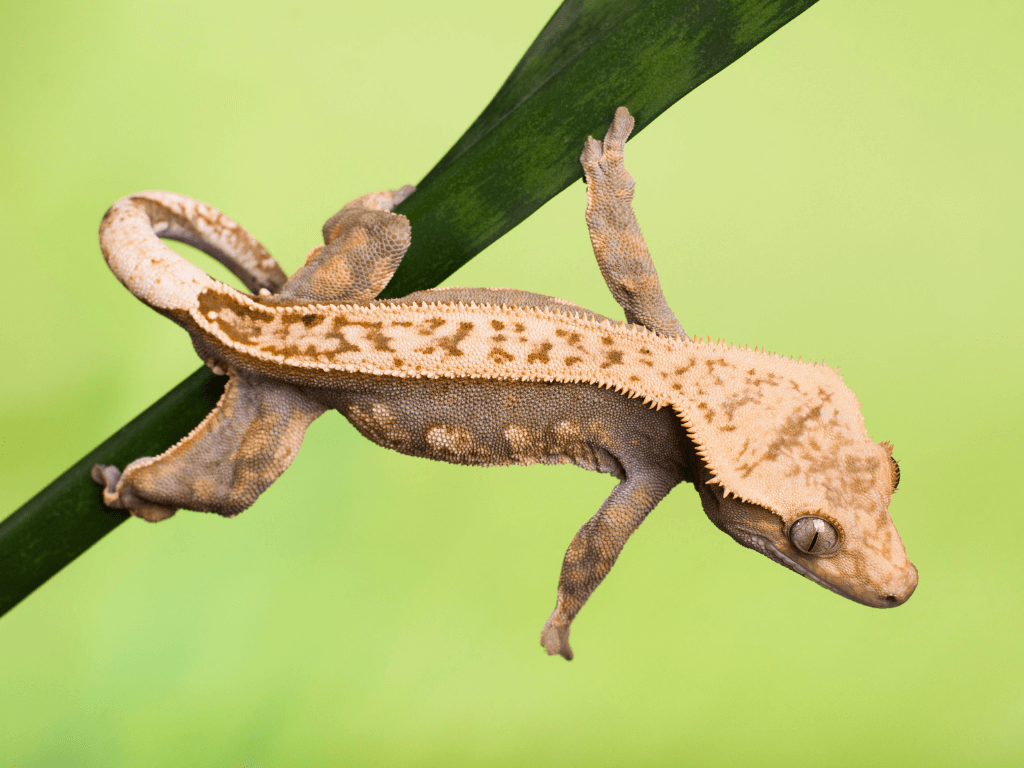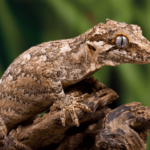Comprehensive Guide to Crested Gecko Care: Habitat, Tank Setup, and Diet

A Complete Guide to Caring for Crested Geckos: Their Environment, Tank Setup, and Diet
Are you considering adopting a crested gecko as a pet? These fascinating creatures can make great companions for first-time reptile owners, but it's important to know how to properly care for them.
In this complete guide to caring for crested geckos, we'll cover everything you need to know about their natural environment, ideal tank conditions, substrate and habitat objects, lighting and temperature, diet, lifespan, and suitability for first-time owners.
By the end of this article, you'll be equipped with all the knowledge you need to provide the best care possible for your new crested gecko friend.
Natural Environment
Crested geckos inhabit the rainforests of New Caledonia, an archipelago in the Pacific Ocean. These arboreal lizards are nocturnal, spending their days tucked away in tree hollows and under leaves. In the wild, they dine on insects and fruits, so recreating this environment in a tank setup is essential for their health and happiness.
Creating a crested gecko's ideal habitat requires knowledge of its natural environment. Rainforests boast warm, humid temperatures of 70-80°F and a humidity level of 70-80%. To replicate this, a misting system or manual misting can be used.

Additionally, their tank should be equipped with plenty of branches and plants for climbing and exercise. Hiding spots like cork bark and coconut hides should also be available for a sense of security.
When assembling a crested gecko's enclosure, it is important to take their natural habitat into consideration. To ensure their well-being, avoid using any chemicals or pesticides in the tank. By replicating their native environment, you can provide your pet with the best possible care.
Ideal Tank Conditions
Setting up the perfect habitat for your Crested Gecko is essential for its health and happiness. An exo-terra glass terrarium with a screen top is ideal, providing ample ventilation for your reptilian friend. A 18x18x24 inch space is recommended to give the gecko enough room to roam and explore. A substrate of coconut fiber and sphagnum moss helps to maintain an optimal humidity level, while live plants further enhance the natural environment.
Temperature and lighting are of the essence when creating a habitat for your Crested Gecko. The temperature should remain between 72-78°F during the day and 65-75°F at night, with a basking area of around 85°F. A UVB light should be provided to furnish the gecko with the necessary Vitamin D3, which should be replaced every 6-12 months.
By constructing an appropriate habitat, you are not only ensuring the gecko's well-being but creating an aesthetically pleasing environment.
Substrate and Habitat Objects
Creating a cozy habitat for Crested Geckos requires selecting the proper substrate. Options include coconut fiber, sphagnum moss, or paper towels; sand and rocks should be avoided since these could cause impaction. Moreover, incorporating habitat objects such as branches and plants offers geckos places to climb and take refuge, making them feel at home.
When selecting habitat objects for Crested Geckos, safety and appropriateness is key. Geckos love to climb, so offering branches or vines for them to perch on is essential. Make sure these items are firmly secured to prevent any accidents. Additionally, plants provide geckos with shelter and private spots, granting them a sense of security.

Establishing an inviting and stimulating environment for your geckos is as easy as providing the right substrate and habitat objects. By choosing suitable materials and giving them many opportunities to clamber, hide, and explore, you can ensure your gecko's many years of health and well-being.
Consider researching the natural environment of these amazing creatures in the rainforests of New Caledonia to better replicate ideal conditions in your gecko's habitat.
Lighting and Temperature
Creating an ideal environment for a Crested Gecko is essential for its health and well-being. Proper temperature and luminosity conditions are of paramount importance. Temperature range should be kept between 72-78°F during the day and 65-75°F at night and can be regulated using a heat mat or a ceramic heat emitter. When it comes to lighting, a 12-hour cycle is recommended with a mix of natural and artificial light, as these reptiles are nocturnal and sensitive to bright lighting.
Moreover, the Crested Gecko's diet must not be neglected.
A commercial diet is a convenient and nutritious option, although it should be supplemented with insects and fruits to avoid nutrient deficiencies. With the right care, these reptiles can live up to 15-20 years.
Crafting a suitable habitat for Crested Geckos is essential for their well-being. Temperature and lighting are of utmost importance and should be monitored regularly. The ideal temperature range is between 72-78°F during the day and 65-75°F at night, which can be achieved using a heat mat or a ceramic heat emitter.
For lighting, a 12-hour cycle is recommended, with a combination of natural and artificial light. It's important to avoid bright sources of light, as Crested Geckos are sensitive to them. Furthermore, providing them with a balanced gecko diet is key to preventing nutrient imbalances. With the right care, these reptiles can live up to 15-20 years.
Creating a suitable habitat for Crested Geckos is essential for their health and well-being. For optimal living conditions, it's important to provide the right temperature and lighting. Temperatures should range between 72-78°F during the day and 65-75°F at night, which can be achieved using a heat mat or a ceramic heat emitter.
For lighting, a 12-hour cycle is recommended, with a mix of natural and artificial light. It's also essential to provide them with a balanced gecko diet, including commercial diets, insects, and fruits, to prevent nutrient deficiencies. With the right care, these reptiles can live up to 15-20 years.
Ensuring the optimal living conditions for Crested Geckos is key to their well-being. Temperature and lighting should be carefully monitored and adjusted when needed. Temperature range should be between 72-78°F during the day and 65-75°F at
Commercial Crested Gecko Diet

For Crested Geckos, commercial diets are a popular choice for owners. These meals may come in the form of powders or pre-made food and are tailored to provide the necessary nutrients.
However, it's important to ensure the diet is specifically designed for Crested Geckos and not other reptiles. Treats may also be available, though they should be given sparsely.
Supplementing their diet with insects and fruits is a must to prevent nutrient imbalances, as well as offering calcium supplements to ward off deficiencies.
It's important to remember that commercial diets should not be the only source of nourishment for Crested Geckos. Insects and fruits should also be included in their diet to ensure a balanced and diverse array of nutrients. Crickets, dubia roaches, and mealworms are some of the insects that can provide the necessary protein and other nutrients.
You can also offer fruits such as mashed banana, papaya, and mango as a treat, but in moderation. Be sure to gut-load and dust the insects and fruits with calcium and vitamin supplements to guarantee your gecko is receiving the proper nourishment.
For housing, screen cages are a popular option due to their ventilation and security.
Insects and Fruits
A diet comprising insects and fruits is essential for Crested Geckos to remain healthy. In their native environment, these creatures can be found in the rainforests of New Caledonia, where they forage for various insects and fruits. To avoid nutrient imbalances and calcium deficiencies, it is important to find suitable insects and fruits to provide a balanced diet for your Crested Gecko.
Crickets, mealworms, and waxworms are some of the insects that can be used, while fruits such as bananas, papayas, and figs can also be included.
Introducing new foods to a Crested Gecko's diet should be done gradually to prevent digestive problems and stress. It is suggested to utilize tongs or a feeding dish when serving insects. As for fruits, they should be cut into small pieces and placed in a shallow dish. Unconsumed food should always be cleared away to avoid spoilage and pest infestation.

Providing a combination of animal and plant matter is essential for Crested Geckos as they are omnivores. Insects offer protein while fruits give vitamins and minerals. A well-rounded diet is necessary to keep your gecko in optimal health and avoid illnesses. It is wise to do your research and be aware of their dietary requirements before introducing new foods.
Depending on the age and size of a Crested Gecko, a feeding schedule should be established. Juveniles need to be fed more often while adults may only need to be fed every other day. In addition, fresh, clean water should always be available in the gecko habitat, which can be done with a shallow dish or water bottle. By supplying a nutritional diet including insects and fruits, you can guarantee the health of your Crested Gecko.
Lifespan and Suitability for First-time Owners
Crested Geckos are a popular option for novice reptile keepers due to their modest size and straightforward upkeep. These geckos can live up to 15-20 years, making them a long-term responsibility.
Therefore, potential owners should contemplate their capacity to provide steady care and focus on the gecko's lifetime. It is also essential to note that while Crested Geckos are relatively easy to maintain, they still necessitate daily care such as feeding and monitoring their water consumption.
One of the advantages of Crested Geckos for first-time owners is their adaptability to many living conditions. They can prosper in glass enclosures with screen tops, which are readily available commercially and can be constructed with minimal effort.
Yet, it is also important to consider the gecko's natural habitat and try to replicate those conditions as closely as feasible. By giving a suitable habitat, owners can guarantee the gecko's health and durability.
Although Crested Geckos may appear like low-maintenance pet, it is essential to remember that they still require regular attention and care. As a novice owner, it is essential to research and educates oneself on the gecko's necessities and behaviors.
This involves understanding their dietary requirements, arranging an appropriate habitat, and inspecting their well-being.
Furthermore, owners should be prepared to provide regular veterinary care and look for medical attention if needed.
Conclusion
In conclusion, caring for Crested Geckos requires a balance of understanding their natural habitat in the wild and replicating ideal tank conditions. Providing the correct substrate, habitat objects, lighting, temperature, and diet is essential for their health and longevity.
Commercial Crested Gecko diets and glass enclosures with screen tops are commonly used for housing, but understanding the natural environment of wild Crested Geckos can also aid in their care.
With a lifespan of up to 15-20 years, Crested Geckos make great pets for first-time reptile owners who are willing to provide the necessary care and attention.



Leave a Reply